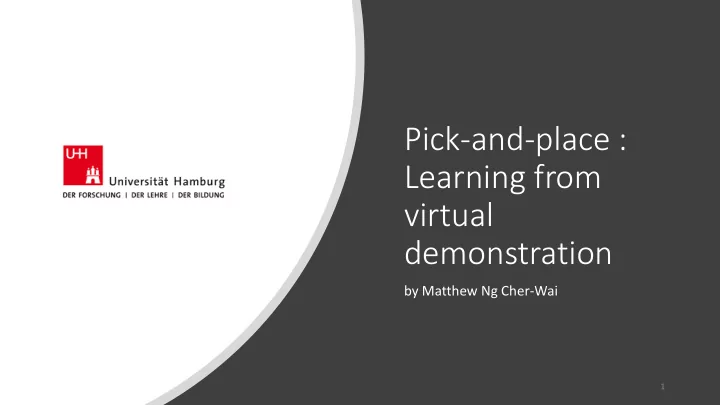

Pick-and-place : Learning from virtual demonstration by Matthew Ng Cher-Wai 1
Today’s Seminar 1. Introduction • What is VR? • What is Learning from Demonstration (LfD)? 2. Common limitations of LfD 3. VR Teleoperation (Proof) 4. Results of VR Teleoperation 5. Virtual to physical results 6. Conclusion Demonstrations) 2
What is VR? https://www.youtube.com/watch?v=1SlZvuhABGk&t=35s Demonstrations) 3
What is VR? https://www.youtube.com/watch?v=bv7I8nMV914&t=19s Demonstrations) 4
What is VR? • Simulated environmental experience • Headsets, sensors and controllers [7] • User is able to move, act and perform tasks within the virtual space • Eg. Google Cardboard, HTC Vive, Virtuix Omni treadmill Demonstrations) 5
What is Learning from Demonstration (LfD)? • A method of teaching robots new tasks • Does not utilize programming • Allows for intuitive programming in more novel situations Demonstrations) 6
Task at hand • Two main papers in question today • One to prove VR as a viable tool for learning from demonstration[2] • Second to show how publicly sourced data can be used to train an intelligent robot[1] • Pick-and-place, a general, all-purpose task with many applications Demonstrations) 7
Common limitations of LfD • Different action space[1] • Must be on-site with demonstrators who are familiar with the robot • Teleoperation – Done with keyboard and other input devices, requires robots to operate. • Time consuming[1] Demonstrations) 8
Solutions • Teleoperation using Unity3D generated VR as the input • Crowdsourcing for increased data sets and demonstrations [2] [2] Demonstrations) 9
VR Teleoperation Test - Setup • University of California, Berkeley [2] • Proving that Learning by VR teleoperation could work. • Using HTC Vive VR system with PR2 robot Demonstrations) 10
VR Teleoperation Test - Parameters • Object localization • High-precision control • Handling contact • Multi stage tasks (e.g. Place a toy into a bowl then push the bowl) Demonstrations) 11
VR Teleoperation Test - Results Task Reaching Grasping Pushing Plane Cube Nail Grasp & Grasp – Cloth Place Drop - Push Test 91.6% 97.2% 98.9% 87.5% 85.7% 87.5% 96.0% 83.3% 97.4% Demo 13.7 11.1 16.9 25.0 12.7 13.6 12.3 14.5 10.1 time (min) Avg 41 37 58 47 37 38 68 87 60 Length #demo 200 180 175 319 206 215 109 100 100 Demonstrations) 12
VR Teleoperation Test - Evaluation • Obtained good success rates (83.3 – 98.9%) with <30 minutes of demo time • Achieves tractable sample efficiency • The simple imitation learning algorithm can train successful control policies for a range of real-world manipulation tasks Demonstrations) 13
Proposed VR Solution • Researchers from Brown University, Rhode island • Improvement upon teleoperation in California paper • Using VR simulation as the data collection method[1] • Crowdsourcing VR application for faster data collection[1] Demonstrations) 14
Solution Overview • Perspective of robot taken from wrist cameras and Kinect 2 on head • Virtual representation of Baxter Robot to be the “Avatar” • Public user data will be recorded and stored as data on a AWS or Google cloud. Demonstrations) 15
Solution Overview • Recordings will consist of 6 DOF poses and velocity of VR controllers. • Recordings will be used to train a convolution neural network.[2] Demonstrations) 16
Solution Option 1 – (ROS) • Hosting the simulation of Baxter on Gazebo[1] Calculate joint angles Sends IK Request Move simulation Update [5] transformation tree [6] Demonstrations) 17
Solution Option 1 – (ROS) • Guarantees high accuracy due to usage of the Inverse Kinematics (IK) solver which Baxter has. No mismatch in compatibility. • Requires an ROS Server to be active to handle IK requests. Demonstrations) 18
Solution Option 2 – (Homebrew) • Homebrewed IK solver in C#[1] • No longer requires constant server connection as IK solver is in game. • Actual IK solver within Baxter will be slightly different, thus losing some degrees of accuracy. Demonstrations) 19
Conversion of results from virtual to physical • Using the recordings, extracting information for each demonstration will be possible. • Input for CNN in [2] is a RGB-D image. We can obtain such from the Unity3D simulation. • Using a virtual camera to record color image and depth mask. Demonstrations) 20
Problems in Solution (?) • People on the internet aren’t very pleasant • Users might make malicious demonstrations • Public might not be interested Demonstrations) 21
Problems in Solution (?) • People aside, proof of VR input as learning method is on a real robot. • Reading in the RGB-D images from a simulation is still unproven. • Might not have the correct accuracy as the real-life sensors. Demonstrations) 22
Problems in Solution (?) • When the video of the researchers previous work to the Vive subreddit[1] • The post received 101 upvotes and 32 comments[1] • Many of aforementioned comments were to try out their system • Assume half have the time to participate (still have ~ 50 testers) Demonstrations) 23
Conclusion • Teleoperation is proven to be sufficiently effective. • Solid outline of how to convert crowdsourced data into workable information for a CNN to learn • Public response decent enough to collect a sizeable sample for demonstrations • Untested, but promising Demonstrations) 24
Questions? Demonstrations) 25
References • [1] ‘’Learning from crowdsourced virtual reality demonstrations’’, published in the Proceedings of the 1st International Workshop on Virtual, Augmented, and Mixed Reality for HRI At: Chicago, IL, USA in March 2018 by Eric Rosen, David Whitney and Stefanie Tellex • [2] “Deep Imitation Learning for Complex Manipulation Tasks from Virtual Reality Teleoperation’’ published in the 2018 IEEE International Conference on Robotics and Automation (ICRA) May 21-25, 2018, Brisbane, Australia by Tianhao Zhang, Zoe McCarthy, Owen Jow, Dennis Lee, Xi Chen, Ken Goldberg and Pieter Abbeel. • [3]Vectorstock.com • [4]ROS.org • [5]3dwarehouse.com • [6]Gazebosim.org • [7] https://www.mysn.de/vr-headsets/vive-pro-full-kit Demonstrations) 26
Recommend
More recommend